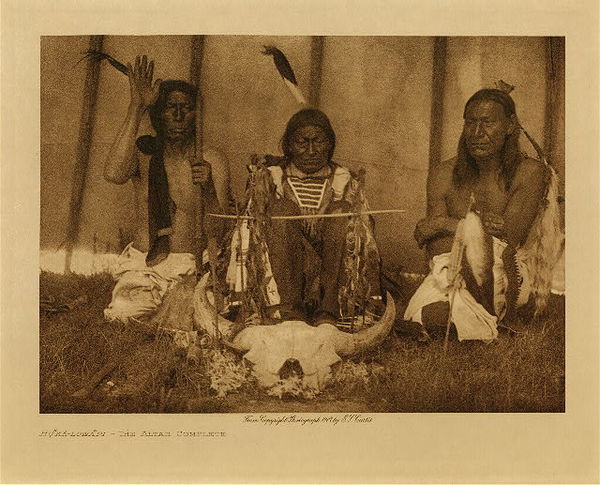Edward S. Curtis (1868-1952)
View Artist Biography
Title:
Huka-Lowapi, The Altar Complete - Sioux
Date:
1907
Size:
Volume, 9.5 x 12.5 inches
Medium:
Vintage Photogravure
"At his bidding the Fire-carrier brings from the Singer's tipi and lays beside Work-do a bundle containing the four cherry sticks, the ear of corn, the eagle-feathers, the two Hunka pipes, and the red and blue paint — all to be used in preparing the altar. The bundle is passed through the sacred smoke. Returning to the Singer's tipi the Fire-carrier receives another skin, which he fills with sage and brings to the wakán-tipi. Spreading it between himself and the altar-space, Work-do calls for the buffalo-skull, which the Fire-carrier brings, wrapped in a buffalo-skin given him by the Singer, and lays tenderly on the sage. Work-do as cautiously removes the covering. He now thoroughly works a bit of red paint into a piece of buffalo-tallow, and purifies, first this mixture, then a roll of buffalo hair and a braid of sweet-grass. The hair and the sweet-grass he extends to the buffalo-skull, and after offering them to the spirits of the four quarters feigns to mark a line across its face from left temple to right, just above the orbits. After brushing the hair and grass downward over the face of the skull as if washing it, he offers the reddened tallow to the four spirits and paints a line across the forehead of the skull, with others down the right cheek, nose, and left cheek, and a few stripes on the horns. Back of the skull he plants the two forked sticks, lays the third wand across them, and leans the two Hunka pipes from the ground immediately in front of him to the cross-stick. Beneath it are laid two buffalo-skin rattles. The fourth stick with the ear of corn impaled on its tip and the eagle-feathers, one for each initiate, attached lower down, is implanted to the left of the two forked sticks and in a line with them. The altar is now complete." -Edward S. Curtis in "The North American Indian"
This Edward Curtis photo was taken in 1907 of a completed ceremonial altar. Pictured are 3 Natives with a large buffalo skull in front of them. The piece was printed by Edward S. Curtis on Dutch Van Gelder and is available for sale in our Aspen Art Gallery.
This Edward Curtis photo was taken in 1907 of a completed ceremonial altar. Pictured are 3 Natives with a large buffalo skull in front of them. The piece was printed by Edward S. Curtis on Dutch Van Gelder and is available for sale in our Aspen Art Gallery.
